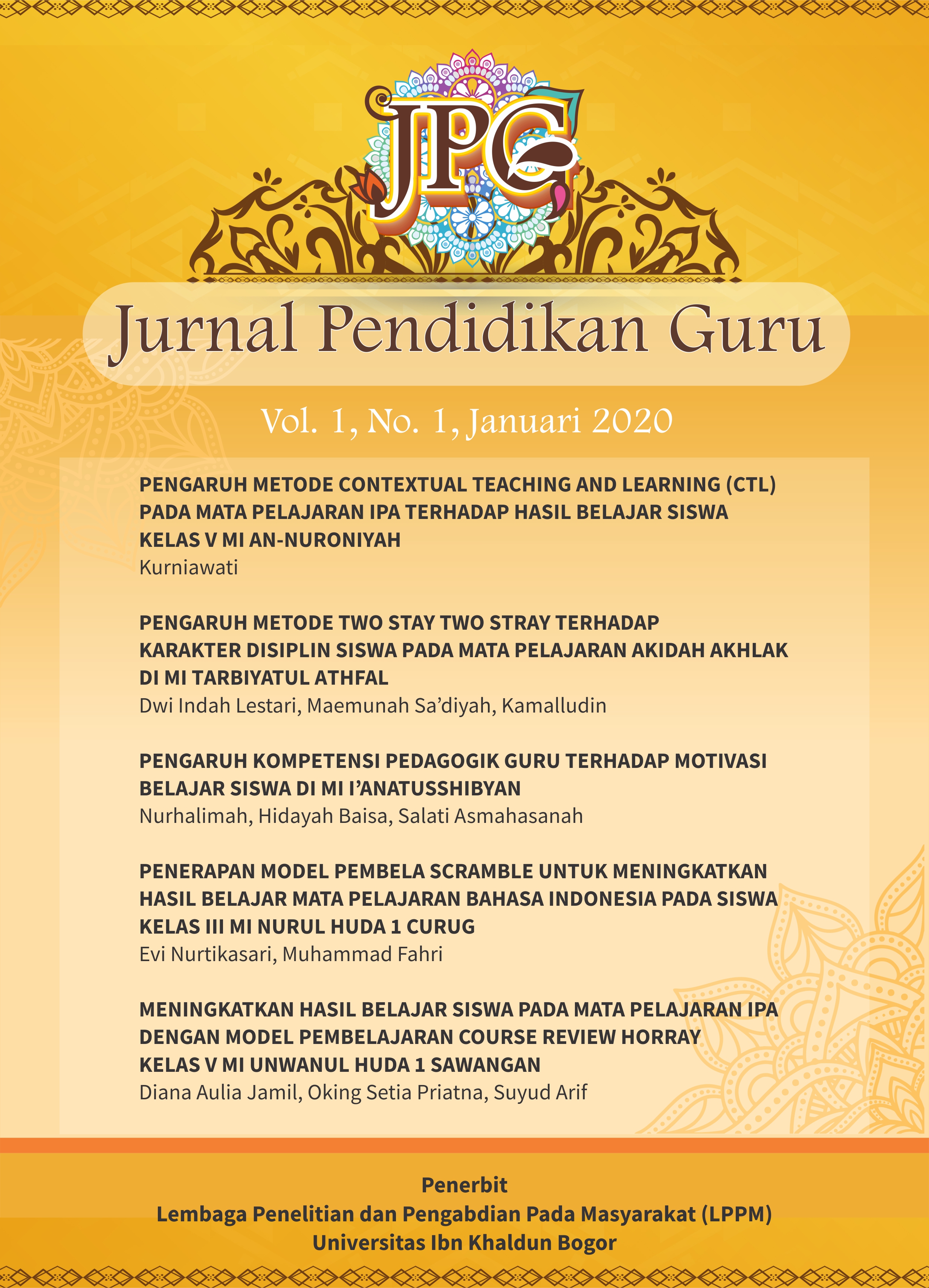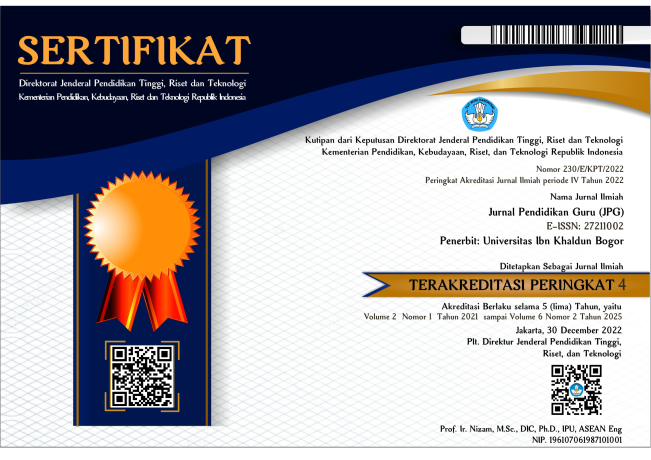PENGARUH METODE CONTEXTUAL TEACHING AND LEARNING ( CTL) PADA MATA PELAJARAN IPA TERHADAP HASIL BELAJAR SISWA KELAS V MI AN-NURONIYAH
DOI:
https://doi.org/10.32832/jpg.v1i1.2676Keywords:
learning outcome, science, methods Contextual Teaching and LearningAbstract
This research aims to to increase result of learning at subject of IPA at least reaching KKM ( 70) by using method of Contextual Teaching and Learning that leads students to be active, goodness in cooperating, question and answer, searching answer, explaining and also pay attention to the material described by friends
Research type the used of Research Of Action Class ( PTK) classroom action by research conducted by the research of V grade teachers through 3 cycles. Where each cycle is carried out 2 meetings each cycle consisting of four aktivities namely planning,impleminting,observing,evaluatinf, and reflecting
Pursuant to result of research, reached result in each natural cycle of improvement. In cycle of I percentage of student activity 39,28%. in cycle of II percentage of student activity 85,71%. in cycle of III, percentage of student aktifitas 92,85%. As well as the result of student evaluation each cycle also experience of improvement. in cycle of I only 14 student or 58,33% complete student. In cycle of II there were 19 student or 79,16% complete student. In cycle of III there were 23 student or 95,83% complete student.
Based on the results obtained, the can know that applying of method study of Contextual Teaching Learning and can improve result learning IPA outcomes in V grade students MI AN-NURONIYAH
This research aims to to increase result of learning at subject of IPA at least reaching KKM ( 70) by using method of Contextual Teaching and Learning that leads students to be active, goodness in cooperating, question and answer, searching answer, explaining and also pay attention to the material described by friends
Research type the used of Research Of Action Class ( PTK) classroom action by research conducted by the research of V grade teachers through 3 cycles. Where each cycle is carried out 2 meetings each cycle consisting of four aktivities namely planning,impleminting,observing,evaluatinf, and reflecting
Pursuant to result of research, reached result in each natural cycle of improvement. In cycle of I percentage of student activity 39,28%. in cycle of II percentage of student activity 85,71%. in cycle of III, percentage of student aktifitas 92,85%. As well as the result of student evaluation each cycle also experience of improvement. in cycle of I only 14 student or 58,33% complete student. In cycle of II there were 19 student or 79,16% complete student. In cycle of III there were 23 student or 95,83% complete student.
Based on the results obtained, the can know that applying of method study of Contextual Teaching Learning and can improve result learning IPA outcomes in V grade students MI AN-NURONIYAH
References
Asih , Eka. Metodologi Pembelajaran IPA. Jakarta : PT. Bumi aksara.
Dedy Kustawan. Analisis hasil belajar. Jakarta Timur : PT. Luxima Metro Media.
Dimyati,Mudjiono. Belajar dan pembelajaran. Jakarta: Rineka Cipta,2013
Elaine. CTL (Contextual Teaching and Learning). Bandung : Penerbit Kaifa.
Heris,Afrilianto. Langkah Praktis Penelitian Tindakan Kelas Bagi Guru. Bandung : PT. Refika Aditama.
Majid, Abdul. Pembelajaran Tematik Terpadu. Bandung : PT REMAJA ROSDAKARYA. 2017
Ni Nyoman, Putu, Ratih. Belajar dan Pembelajaran. Depok : Rajawali Pers,2018.
Pudyo Susanto. Belajar Tuntas. Jakarta : Bumi Aksara,2018
Purwanto. Evaluasi Hasil Belajar. Yogyakarta : PUSTAKA BELAJAR. 2011
Sumiati, Asra. Metode Pembelajaran. Bandung : CV Wacana prima, 2015.
Syaiful Sagala. Konsep dan Makna Pembelajaran. Bandung : Alfabeta,2013
Tursinawati. 2013Analisis Kemunculan Sikap Ilmiah Siswa Dalam Pelaksanaan Percobaan Pada Pembelajaran IPA di SD Kota Banda Aceh. Jurnal Pionir, Vol,1:1.
Downloads
Published
How to Cite
Issue
Section
License
Authors grant the journal copyright of the work licensed under a Creative Commons Attribution License that allows others to share the work with an acknowledgement of the work's authorship and initial publication in this journal.

















